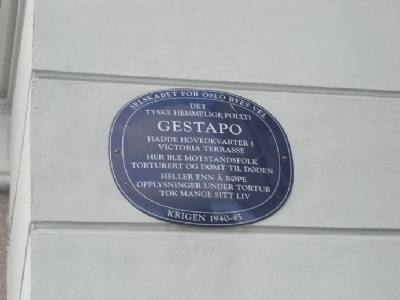Oslo - Victoria Terrasse
For a short time, the German Security Police (SIPO) had its headquarters in the parliament building (Stortinget) in Oslo, however, in early May 1940, SIPO and SD headquarters moved to Victoria Terrasse in central Oslo. The prisoners who were interrogated at Victoria Terrasse were usually came from the main prison at Möllergata 19. It was from Victoria Terrasse the Germans’ Polizeihäftlingslager in Norway was administered. On September 25, 1942, the British air force (RAF) carried out a unsuccessful bombing raid on headquarters, killing 80 civilians.
In 1945, the actual SS command chain in Norway was organized like this. Highest in SS rank in Norway and subordinated only to Himmler was SS-Obergruppenführer Wilhelm Rediess. Subordinated to Rediess were a number of SS and Police Leaders responsible for each area. Oslo was under the SSPF Süd-Norwegen and its head was SS Gruppenführer Jakob Sporrenberg. The head of SIPO and SD in Norway was SS-Oberführer Heinrich Fehlis. The Gestapo was administratively within SIPO and the Gestapo head in Norway was SS-Hauptsturmführer Hellmuth Reinhard. Head of the Gestapo in Oslo and based at Victoria Terrasse was SS-Hauptsturmführer Siegfried Fehmer. The head of the Norwegian State Police (state policy) and the Security Police (sikkerhetspolitiet) was Karl Marthinsen.
Current status: Preserved with memorial tablet (2009).
Address: Victoria Terrasse 5, 0251 Oslo.
Get there: Tram och metro to Nationaltheatret Station.
Follow up in books: Höhne, Heinz: The Order of the Death’s Head: The story of Hitler’s SS (1969).


In 2011, the Norwegian foreign ministry is housed in the building. During the war, about 500 camps were established in Norway with different functions, but there were only six Polizeihäftlingslager under the control of SIPO. The rest were under other authorities. The first was Ulven in southwest Norway, established in 1940. Second was Grini in Oslo. Third and fourth was Falstad outside Levanger and Sydspissen in Tromsdalen. These were set up in 1941. In 1943 Ulven was gradually replaced by Espeland outside Bergen and Sydspissen was replaced by Kokkebarsletta in Tromsdalen. Within each geographical area, these camps were administered by local SIPO offices. Only at Falstad was a special execution place set up near the camp. In other places, prisoners to be executed were taken to other places. At Espeland there were neither death sentences nor executions.